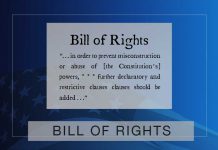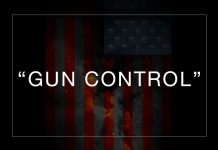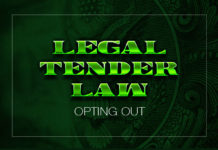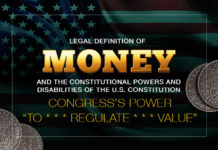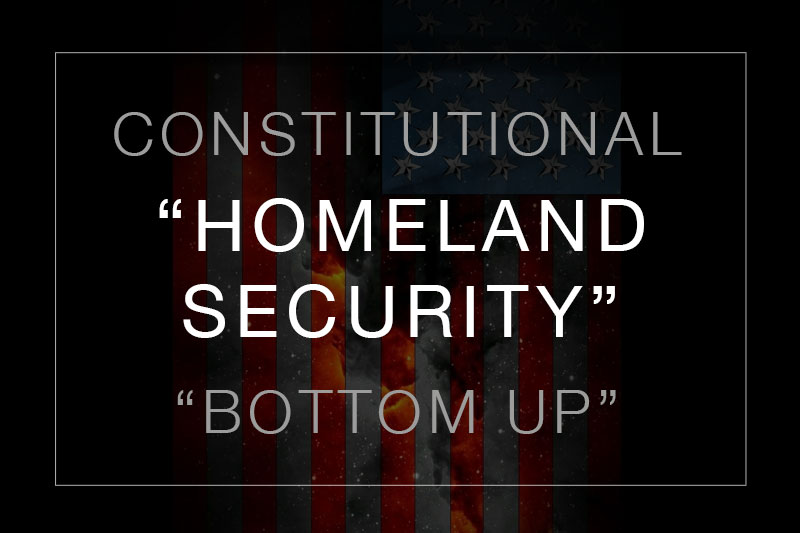Last Updated on November 23, 2021 by Constitutional Militia
Obviously, no sane individual would voluntarily turn in gold or silver at confiscatory rates of exchange—or at least no sane individual not terrorized into compliance. So, just as in the 1930s, politicians bent on a seizure of gold and silver today would turn immediately to the force of “law”—or, more realistically, to the law of force:
(1) The first step would be to keep all gold and silver subject to the Treasury’s ready grasp, by outlawing their exportation and setting up strict inspections of travellers for the precious metals at, and other barriers to the metals’ transportation across, this country’s borders.
(2) The second step would be to impose on all Americans mandatory reporting to the Treasury of all gold and silver physically within their possession or subject to their control within the United States, and of all interests, legal or equitable, that they might claim in the precious metals wherever situated. Individuals would be required to disclose not only their own possession or control of actual metal, or any interest therein, but also any attempt by a family member, business associate, friend, neighbor, or acquaintance to conceal the latter’s possession, control, or interest.
(3) The third step would be to rake the precious metals into the Treasury. Within the banks, all safe-deposit boxes would be “frozen,” their contents subjected to inspection, and nothing contained therein removed without license from the Treasury or (even more likely) the Department of Homeland Security. Any gold or silver discovered in the boxes would be seized—with payment of nominal compensation if the contents had been properly reported prior to inspection, or outright confiscation without compensation (that is, forfeiture) and prosecution of the holders if no timely disclosure had been made. Outside the banks, all holders of gold or silver (or of any interest, legal or equitable, therein) would be required to surrender the metal (or their interest) to the Treasury by a specified date. If the gold or silver were situated outside the United States, the owners would be required to repatriate it for seizure. Again, holders of gold who reported it to the Treasury prior to surrender would receive nominal compensation; whereas any who failed to report their holdings would, upon discovery thereof, suffer forfeiture of the metals, and then prosecution.
Home
(4) All these requirements would be enforced with the most brutal of sanctions. During the 1930s, those who withheld their gold faced $10,000 in fines and ten years in prison. With depreciation in the purchasing power of currency and inflation in the sadism of public officials since that era, the minimum penalties for attempted evasion of some future gold and silver seizure might easily rise to $250,000 in fines and 25 years in prison. Detection, too, would likely exhibit barbaric tactics rarely witnessed in the 1930s, but now becoming commonplace with America’s increasingly para-militarized “law enforcement”: namely, SWAT teams rampaging from house to house under color of search warrants the “probable cause” underlying which would be as gossamer thin as the compunctions the ninja-clothed gunmen would feel about shooting down anyone who might offer the least semblance of resistance, real or imagined.
In short, a new gold and silver seizure would be conducted on the scale and with the ferocity of a veritable war of financial terror directed against every common American. For, indeed, the life or death of the bankers and their political puppets would be at stake as they never really were in the 1930s. After all, under the economic conditions of the 1930s the Federal Reserve System could probably have survived a relatively short-term “suspension of specie payments” without a gold seizure, if Roosevelt had not imposed the crackpot economic nostrums of his New Deal upon the country, prolonging the Depression until World War II. In a future crisis, however, unless the bankers and their political cronies could quickly “stabilize” the System by creating a new currency with some genuine economic and especially political credibility, the whole rotten pyramid of banking-cum-political power might collapse overnight from its elephantiasis of public and private debt, with disastrous consequences for the Establishment.
In keeping with its true nature, any future seizure of gold and silver would undoubtedly be labelled a “war measure” (albeit, of course, without identifying the American people as the politicians’ and bankers’ real enemies). To ape the precedent of the 1930s, and to lend the seizure a contemporary legal veneer, such a characterization would be necessary. In 1933, Roosevelt began the sequence of events that culminated in the original gold seizure by “freezing” all gold in the banks, under color of the Trading with the Enemy Act—a “war measure” from World War I quite inapplicable in peacetime, but which Congress immediately amended to whitewash Roosevelt’s usurpation of power. Today, the applicable statute provides that
[d]uring the time of war, the President may * * * investigate, regulate, or prohibit, any transactions in foreign exchange, transfers of credit or payments between, by, through, or to any banking institution, and the importing, exporting, hoarding, melting, or earmarking of gold or silver coin or bullion, currency or securities * * *.
Title 12, United States Code, section 95a(1)(A).
That the President may exercise these powers only “[d]uring the time of war” also applied under the Trading with the Enemy Act; but that meant nothing to Roosevelt, who successfully pretended to employ that Act in time of peace. And it would probably not deter any future President, either, from twisting the present statute to his malign purposes whenever the Establishment demanded it.
Moreover, the limitation would not be hard to finesse, rhetorically at least, inasmuch as all too many Americans have become used to being told—and apparently to believing—that their country is at “war,” even without a declaration of “War” that the Constitution requires under Article I, Section 8, Clause 11. So, what the Establishment obviously intends to be a never-ending “war on terror” would surely be held to qualify as “[d]uring the time of war,” especially if a monetary and banking crisis arose coincidentally with a widespread use of gold and silver by Muslims as their media of exchange.
Yet, if a seizure of gold and silver could—and in a dire financial crisis probably would—be undertaken to save the Establishment’s bacon, with what likelihood would it succeed, even to the limited degree that Roosevelt’s gold seizure succeeded in the 1930s?
Unfortunately, the likelihood is not insignificant. The occasion for a seizure would be a monetary and banking crisis so severe that it threatened the continued existence of the Federal Reserve System, the solvency of the Treasury, and even the functioning of the entire domestic economy. In such a situation, a nationwide financial panic would ensue, probably worse than anything experienced during the 1930s. Unlike the 1930s, though, when millions of Americans possessed gold or silver coins and were familiar with the sound money that regularly passed from hand to hand as wages and salaries, and in the consumer economy, today relatively few Americans hold monetary gold or silver in any form, or understand anything at all about money and banking. So without personal experience, knowing nothing relevant to the problem facing them, and unable to evaluate the situation critically, in a severe crisis many Americans would likely believe anything they were told by public officials and the big media—especially if these sources of propaganda, misinformation, and disinformation emphasized that their prescriptions were the only way to restore the economic stability masses of people desperately desired.
Doubtlessly, too, politicians, the big media, and other of the Establishment’s mouthpieces would employ their tried and true “divide-and-conquer” strategy, to turn Americans against one another. In the run-up to a seizure of gold and silver, public officials and the media, following in the cloven hoofprints Roosevelt laid down during the 1930s, would broadcast hysterical attacks against “hoarders”—that is, individuals who wanted to retain their own gold and silver as private property. Inasmuch as in a financial crisis those Americans who had shown the foresight to acquire silver and gold would be better off than those who had not, such political defamation would play on envy, greed, and other vicious emotions to divert the attention of the unfortunate many from the people who had actually caused their misfortune to their innocent, but less unfortunate neighbors. Americans who possessed gold and silver would quickly be demonized as “unpatriotic” if they dared to keep their property for themselves, when public officials and bankers needed it to “stabilize” the monetary and banking systems, restore credit, create jobs, et cetera. Suffering the fate typical of unpopular messengers who bring bad news, those holders of gold and silver who had openly criticized the Federal Reserve System, had spoken up for the restoration of constitutional money, or had predicted a monetary and banking crisis as the inevitable consequence of the politicians’ and bankers’ fallacious policies would be branded dangerous “extremists.”
And if the crisis could somehow be blamed on the Islamic world—as surely it would be were it to break out even coincidentally with Muslims’ adoption of the gold dinar and silver dirham as their media of exchange—then the Establishment could paint the seizure of Americans’ precious metals as an integral part of the “war on terror,” and could thereby condemn the holders of gold and silver as “enemy sympathizers,” “traitors,” or even “enemy combatants,” with all the life-shattering consequences such labelling would entail. Conveniently forgotten, just as it was during the 1930s, would be that the Constitution protects every American in his possession and use of gold and silver as media of exchange, and requires the General Government and the States, and all public officials who “shall be bound by Oath or Affirmation, to support th[e] Constitution” under Article VI, Clause 3, to make gold and silver coin the only official money and legal tender throughout this country.
For Americans who did not possess gold or silver to turn on those who did would be exceedingly myopic—because, in a sufficiently severe monetary and banking crisis, gold and silver would not be the bankers’ and politicians’ only targets. The public debt of the United States amounts to tens and tens of trillions of “dollars,” the private debt of American businesses and individuals umpteen trillions more. All the gold and silver possibly subject to confiscation by the Treasury could never prop up this pyramid of financial profligacy, were its foundations to crumble. Huge amounts of other valuable assets would be necessary, on the economic strength of which the Federal Reserve System could create credible “reserves.” Securities such as stocks, bonds, investment funds, pension funds, and other varieties of income-producing paper would doubtlessly provide irresistible temptations for bankers and politicians desperate to acquire real wealth for the creation of a new fictitious currency to keep the Ponzi-scheme of American political central banking in operation. And, ominously, the statute licensing the President to prohibit the “hoarding * * * of gold or silver coin or bullion” also applies to “securities.” Title 12, United States Code, Section 95a(1)(A).
What about real estate, businesses, even private homes? All these, too, are assets that the Federal Reserve System could use as “reserves” on the basis of which to emit currency. Can anyone believe that, in a crisis threatening the Establishment’s continued domination of this country, the same type of Justices who excogitated the Supreme Court’s Kelo decision could not concoct some theory that combined “eminent domain” with “securitization” and “monetization,” so as to license the Treasury to seize such properties at miniscule prices for the purpose of emitting paper currency “backed” by the much higher free-market value of the property? In the early 1700s, John Law “coined the soil of France” in his wild paper-money scheme. Why, in the course of a financial crisis, could not the Federal Reserve System claim the power to “coin the soil” of America? And with an even more catastrophic result?
In the 1930s, gold was seized to form “reserves” for the emission and redemption of FRNs. But the Federal Reserve System may emit FRNs on the security of essentially ANY asset satisfactory to the regional Federal Reserve Banks and the Board of Governors. So, in the future, on the precedential strength of Roosevelt’s gold seizure ANY asset could be seized for that purpose. That is, no American’s property, of any description, is safe as long as the Federal Reserve System remains in operation, subject to catastrophic failure. The process may start with a seizure simply of gold and silver. But the immense gravitational force of the financial black hole the Establishment would need to fill would soon expand it to a seizure of whatever valuable assets could be grabbed.
To be sure, at some point in such a wide-ranging expropriation of assets even the dullest American would have to wake up. So, right from the start, the seizure would probably go beyond the two precious metals, to take in all of the four metals of freedom under constitutional government: namely, gold and silver, steel and lead. When real money is being seized, firearms too will be targeted. Perhaps even earlier.
Which is why returning the States to gold and silver as their media of exchange—immediately, if not sooner—is so important. See For no seizure engineered by the General Government and the Federal Reserve System can constitutionally reach precious metals the States are using for their own governmental purposes. And with this must come a revitalization of “the Militia of the several States”—in as many States as possible, and certainly in those States that incorporate gold and silver into their financial operations. Such is the only plan this author can imagine that might yet salvage something worthwhile from the mess the Establishment has created in this country, when the house of cards comes tumbling down.
In the final analysis, everything depends upon depriving the Establishment of its “divide-and-conquer” strategy. To prevail in the struggle for national self-preservation, common Americans must neither divide themselves nor let themselves be divided over secondary, indecisive issues. Unless Americans unite to reassert their control over the two great powers of government—the Power of the Purse (constitutional “Money”) and especially the Power of the Sword (“the Militia of the several States”)—they are lost, and with them this country, too, irretrievably. But if Americans can firmly grasp these powers in their own hands, all else will follow. As to these matters, then, every American should take heed of Benjamin Franklin’s warning, that if we do not all hang together, we shall every one hang separately. For part 1 click below.
©2006 Edwin Vieira, Jr. – All Rights Reserved.







